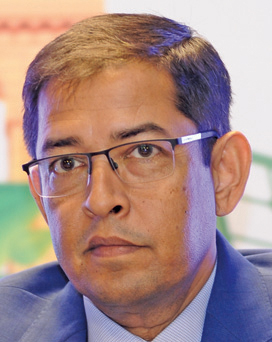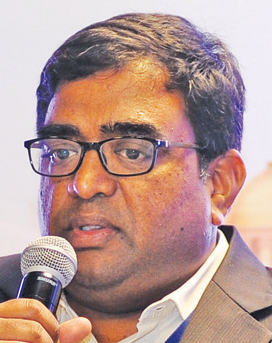As the 2022 deadline for renewable capacity addition draws nearer, the solar energy industry remains divided on whether the targets will be achieved in time. While the utility-scale target seems achievable on the whole, experts agree that India is still far from installing 40 GW of rooftop solar. Regulatory and policy gaps continue to exist in the segment and need government intervention at both central and state levels. At a recent event organised by Renewable Watch on “Achieving the 100 GW Target: Need for Progressive Policies and Technologies”, key developers and technology experts discussed the current status of solar power development, the issues facing the segment and the market outlook…
Do you think India can achieve its 100 GW by 2022 solar target?

Sujoy Ghosh
India will reach the target of installing 100 GW of solar capacity, but this may not happen by 2020. India is one of the few countries in the world that have a significant energy demand and growth potential. Even a 5 per cent year-on-year growth rate assumption for solar capacity addition is significant. In addition, a bulk of the total installed grid capacity of around 350 GW comprises thermal-based generation, which is old and inefficient. Thus, from our perspective, India offers a great opportunity for renewable growth.
I also think that it is irrelevant to talk about capacity addition numbers such as 200 GW or 300 GW in isolation. Instead, we should question if the country will be able to reach these numbers by 2022 or 2024.

Matthias Haag
Germany has a large existing nuclear and thermal capacity, but the country still aims to shift to clean energy. The movement to achieve this goal, irrespective of the costs, is driven by a social responsibility that we have towards the next generations. I believe renewables are cheaper than conventional power plants. Thus, all the existing thermal and nuclear power plants need to be retired and generation should be shifted to renewable energy so as to sustain the future of this planet.

Dr Satyendra Kumar
India has the demand, the technology as well as the political will to achieve the targets. Now the question arises whether the target is achievable by 2022 or 2024. A general decline in the economy’s growth may lead to a decline in renewable capacity addition. If the growth rate increases, then the sector will also flourish.

Vinay Kumar
We should set aside the 100 GW target and look at how utilities purchase power in India. They look for affordability, sustainability and flexibility. There is no doubt that sustainability is the key for future generations. On the affordability front, solar energy has already crossed the barrier and is not an issue. However, we now face a challenge on the flexibility front, which can only be resolved with technology improvements and the increase in market demand.
What are your views on the 40 GW rooftop solar target?
Sujoy Ghosh
The rooftop solar market is adding a capacity of 1,000 MW per year and probably by 2022 the country will install 7,000-8,000 MW. This is a good achievement considering the issues we have in terms of regulations, technology and finance.
Matthias Haag
Germany has a system of feed-in tariffs (FiTs). The FiTs set for rooftop solar power are high, which incentivises the consumers and has helped in large rooftop capacity addition. In India, focusing on the rooftop market first and then going for utility-scale projects could be a good strategy.

Rahul Mishra
We are nowhere near achieving the target set for the rooftop solar segment and it seems impossible to achieve 40 GW of installed capacity by 2022. Urgent government support on the policy front is required and the efforts should be resonated on the state level too. Issues related to net metering and energy storage still exist in this sector, lowering discom revenues. Moreover, the Indian rooftop solar segment has small and fragmented players that may not be able to contribute towards large capacity additions. However, large players like Trina Solar have started entering this market with innovative products like solar kits, and may help increase the number of rooftop projects in the future.
States lagging in solar capacity addition such as Uttar Pradesh, Haryana, Odisha and Kerala are now floating tenders. Are developers interested in establishing their plants in these states?
Dr Satyendra Kumar
Most of these states should work in sync with the discoms to incentivise and support the developers. Taking the case of Haryana, though the state is doing well economically, solar penetration is one of the lowest here despite the fact that it has a huge potential for the rooftop market. The same scenario can be seen in the other states.
Vinay Kumar
It is true that there are huge gaps between the renewable purchase obligation (RPO) targets and the actual numbers achieved in these states. In addition, the utilities are reluctant to accept the high tariffs discovered in these states.
The developers do take into account the geo-political risk and the credit rating of the state while submitting their bids. They also factor in the RPO compliance of the state. All these reasons subsequently lead to an upward trend in tariffs, which has been observed in some of the states.
Will the rooftop sector be impacted by the safeguard duty set by the government?
Sujoy Ghosh
The impact of the safeguard duty depends on the project commissioning deadlines. For projects with longer deadlines, if the auctions take place today, the modules will be shipped after August 2020. As the safeguard duties will last for only two years, the developers will not consider the additional costs while bidding. For projects with shorter commissioning timelines, developers are approaching the regulators to get a pass-through. If that does not happen, the developers will incorporate the safeguard duty costs in the tariffs while bidding. As seen in the Uttar Pradesh tender, any tariff above Rs 3 per kWh is being cancelled by the implementing agencies. Hence, the adverse impact of the safeguard duty will be seen on projects with shorter commissioning timelines.
Rahul Mishra
Yes, the safeguard duty will impact the rooftop solar market. The commercial rooftop market will be affected the most as industrial users predominantly import modules. Moreover, rooftop solar developers are stuck as they have already signed power purchase agreements (PPAs) and re-negotiation of the tariffs will be time consuming. The impact will not be seen on the government rooftop market as it can use domestically manufactured modules. The growth of the residential rooftop market is minimal and the scale of operations is low. Hence, the duties may not directly impact this market.
How does solar energy help in the sustained growth of electric vehicles (EVs)?
Matthias Haag
EVs can help smoothen and stabilise renewables by serving as battery energy storage systems. In Germany, the FiTs are set for 20 years and in the coming two to three years, many of these tariffs will expire. Thus, an economic way for us could be charging our EVs from solar plants and use the same as battery storage. Moreover, the EV battery can be discharged at night.
Dr Satyendra Kumar
The way we look at our highways is going to change with the introduction of EVs as vehicles in the future will be power generators and consumers. EVs would be a game changer in the battery energy storage industry, if their share in the country’s total vehicles goes up to 10 per cent. As the demand increases and the technologies improve, the costs of the batteries will come down, which will be a positive development for the renewable energy sector.
What are the policy and regulatory gaps that need urgent attention in the solar power segment?
Sujoy Ghosh
We need to reconsider the role of regulations in the Indian power sector. Today, all stakeholders are fixated on tariffs and capacity additions. This mindset cannot lead to sustainability in the renewable energy market. After five years, the renewable energy sector could have the same fate as the thermal energy sector, which is plagued by non-performing assets. Going forward, RPOs may not be necessary to support renewable energy demand owing to the low tariffs. Also, planning proper integration of renewables with the grid is more important than placing higher targets for the sector.
Vinay Kumar
The power sector is in the concurrent list and comes with some inherent flaws. Thus, there is a need to align the state and central regulations. I would wish for just one law that governs the entire power sector in India. Policymakers should also do away with the constant tinkering with the laws.
Rahul Mishra
The biggest challenge is that there is no synchronisation between the policies floated by the central and state governments. Thus, it has become very difficult to implement the policies. Moreover, in the initial one or two years most of the stakeholders are figuring out what needs to be done. The need of the hour is to have less but clear policies. In addition, these policies need to be formulated considering the financial health of discoms to avoid future contingencies.
How have the falling tariffs impacted the quality of solar projects?
Matthias Haag
The selection of the right components does not necessarily mean that the project has a good system design at the end of the day. We have to make sure that the system will perform well in the geographical area where it is located. Some manufacturers do offer products with varying quality levels. Lower quality equipment may be used by developers looking for cost reductions in key components like inverters.
Vinay Kumar
The tariffs are indeed going down as developers are cutting costs while setting up the project. The investment in the projects directly affects the decisions made on the size and quality of the equipment, as well as the overall design of the solar project. Many developers tend to be lax in project quality standards if the project is developed in the build and transfer mode. However, developers are more cautious when they are building and holding the project for the entire term of the PPA.
Rahul Mishra
As a developer, I don’t think anybody is compromising on the key aspects of quality such as design, structure and components. When lenders are involved in any project’s development, it is not possible to compromise on the quality of the solar project. However, the developers are cutting costs on drainage and operations and maintenance of the plants to remain competitive in the market. The drastic changes in land requirements, weight of mounting structures and ISO codes have also led to cost reductions and this has not affected the segment in a negative way. The developers are still producing forecasted energy and are signing long-term service level agreements on key components like modules and inverters.
What is your outlook for the captive power segment in India?
Sujoy Ghosh
Unfortunately, India has a unique problem in the captive power generation market. We are probably the only country where industrial tariffs are much higher than residential tariffs and, therefore, it is not financially feasible to take the industrial customer away from a discom. The commercial and industrial segment is growing in our country, but this growth is slow due to the regulatory uncertainty that persists in the country.
Rahul Mishra
The challenge is that discoms do not want to lose their high-paying industrial customers. From developers’ perspective, it makes sense to diversify the portfolio. Say, out of a total portfolio of 10,000 MW, the capacity earmarked for open access could be 2,000 MW. However, to diversify, a different offtaker base is needed. I think over the next 5 to 10 years, several bilateral transactions will take place, but at a slow pace.



